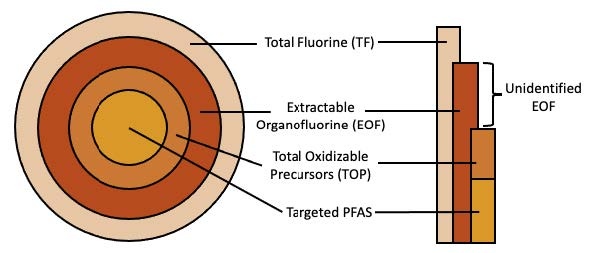As a graduate student and STEEP trainee, I focus on research under the STEEP umbrella of "Sources, Transport, Exposure, and  Effects of PFAS".
Effects of PFAS".
Per- and polyfluoroalkyl substances (PFAS) are a diverse class of anthropogenic organofluorine chemicals with thousands of potential structures that have been intentionally used in consumer products and by industry. Thousands of sites across the United States have been contaminated by PFAS from sources including manufacturing and use of aqueous film forming foams (AFFF) for fire training and firefighting applications. Due to their ubiquitous presence in the environment, over 98% of the U.S. population has detectable levels of PFAS in their serum. Exposure to PFAS has been associated with immune suppression in children, liver toxicity, reproductive toxicity, and various cancers. Major human exposure sources include seafood and drinking water.
Standard targeted mass spectrometry methods pose a major challenge for comprehensively assessing PFAS exposures and accumulation in the environment because they only capture a small fraction of the PFAS used in commerce and released to the environment. The Sunderland Laboratory uses a toolbox of analytical methods for closing the PFAS mass budget. We routinely measure ~40 PFAS using targeted analysis based on liquid chromatography-tandem mass spectrometry (LC-MS/MS) detection. We analyze total fluorine (TF) and extractable organofluorine (EOF) using combustion ion chromatography (CIC) to quantify the total mass of organic and inorganic fluorine in environmental samples. The difference between EOF and targeted PFAS can be further examined by quantifying the concentrations of PFAS precursors oxidized by the total oxidizable precursor (TOP) assay and non-target analysis (NTA) using HRMS can further complement these measurements by providing information on the chemical structures of these precursors in different samples. This toolbox of analytical methods (see below figure) will allow me to fully explore the extent of PFAS contamination in different environmental samples.

My overarching research goal is to better understand if PFAS precursors that persist in the aquatic environment accumulate in biota across different field settings. The central hypothesis of my research is that exposures to PFAS are being substantially underestimated by targeted measurements due to the prevalence of precursors that accumulate and/or biotransform. Using a combination of field sampling, targeted and non-targeted analytical techniques, and novel statistical methods, my research aims to better understand if and how unidentified organofluorine compounds accumulate in aquatic ecosystems. This knowledge is essential for comprehensively assessing human and wildlife exposures to unknown PFAS.


